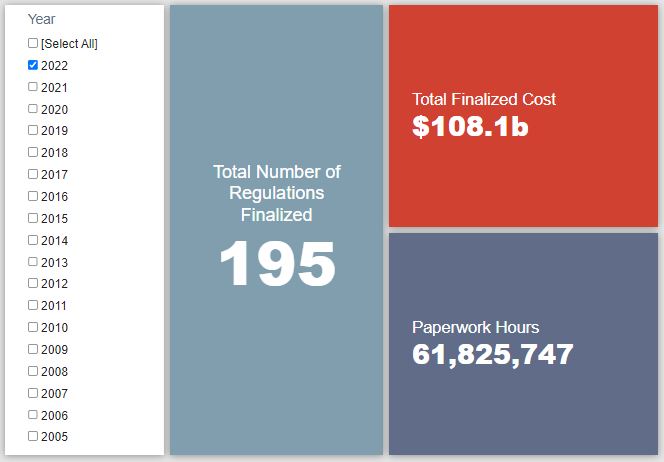Week in Regulation
October 24, 2022
Court Decision Eclipses Quiet Rulemaking Week
If one was looking for the most notable regulatory development last week, one would be wise to look to the appellate court docket instead of the Federal Register. There were nine rulemakings with some quantifiable impact. None, however, exceeded $10 million in costs. A Department of Transportation (DOT) proposed rule regarding airfare fee disclosures provided the “highlight” of the week. Across all rulemakings, agencies published $16.2 million in total net costs and added 155,630 annual paperwork burden hours.
REGULATORY TOPLINES
- Proposed Rules: 42
- Final Rules: 55
- 2022 Total Pages: 64,041
- 2022 Final Rule Costs: $108.1 billion
- 2022 Proposed Rule Costs: $124.6 billion
NOTABLE REGULATORY ACTIONS
The nominally most significant rulemaking of this understated week was DOT’s proposed rule on “Enhancing Transparency of Airline Ancillary Service Fees.” The proposal seeks:
To require U.S. air carriers, foreign air carriers, and ticket agents to clearly disclose passenger-specific or itinerary-specific baggage fees, change fees, and cancellation fees to consumers whenever fare and schedule information is provided to consumers for flights to, within, and from the United States.
DOT’s cost-benefit analysis of the rulemaking’s potential impact is largely qualitative, citing “a lack of data and other significant uncertainties.” Affected air carriers will, however, need to affirmatively report to DOT on their compliance with the measure. The agency estimates that the administrative burdens involved with those reports would involve roughly 116,000 hours of paperwork annually with $3.1 million in commensurate costs.
TRACKING THE ADMINISTRATIONS
As we have already seen from executive orders and memos, the Biden Administration will surely provide plenty of contrasts with the Trump Administration on the regulatory front. And while there is a general expectation that the current administration will seek to broadly restore Obama-esque regulatory actions, there will also be areas where it charts its own course. Since the AAF RegRodeo data extend back to 2005, it is possible to provide weekly updates on how the top-level trends of President Biden’s regulatory record track with those of his two most recent predecessors. The following table provides the cumulative totals of final rules containing some quantified economic impact from each administration through this point in their respective terms.
![]()
With the airfare fee rulemaking discussed above still only a proposed rule, there was very little happening on the final rule front for the Biden Administration last week. The Trump Administration saw a similarly stagnant stretch in the middle of October 2018. The Obama Administration, however, did see some notable developments. Obama-era final rule costs increased by nearly $3.4 billion and paperwork increased by 973,000 hours. A Department of Labor rule on fiduciary disclosures provided the bulk of those costs, while a Securities and Exchange Commission rule provided most of the paperwork spike.
THIS WEEK’S REGULATORY PICTURE
This week, a federal court finds the Consumer Financial Protection Bureau’s (CFPB) funding structure unconstitutional.

On October 19, the United States Court of Appeals for the Fifth Circuit released its opinion in a case brought by payday lenders against the CFPB. The court found that the CFPB’s unique funding structure is unconstitutional and vacated a rule on payday lending.
When Congress created the CFPB as part of the Dodd-Frank Act in 2010, it sought to insulate the agency’s budget from politics by providing for direct funding through the Federal Reserve (the Fed). The CFPB’s director simply requests the level of annual funding they deem necessary to fulfill the agency’s needs, and as long as that amount does not exceed 12 percent of the Fed’s operating budget, the Fed transfers the money. This structure is said to be “double insulated” from congressional appropriations because not only is the CFPB not directly funded by Congress, but neither is the Fed. The Fed is funded through interest earned on the securities it owns and assessments the agency levies on banks within the Federal Reserve system, though it does have to transfer income above a certain threshold to the Treasury.
The court decided that this structure violates the Constitution’s provision that only Congress maintains the power of the purse. It also determined that not only does Congress have that sole power, but it also cannot give it away to another branch of government in the same manner as it did to the CFPB. The court also differentiated the Fed’s structure from the CFPB’s because, while the Fed must transfer to Treasury any excess funds, there is no requirement for the CFPB to do that to the Fed or Treasury – it gets to keep any extra funds for itself in perpetuity.
After finding the CFPB’s funding structure unconstitutional, the court also vacated the agency’s 2017 rule covering Payday, Vehicle Title, and Certain High-Cost Installment Loans. It did so not because Congress had not authorized such authority, but because “the agency lacked the wherewithal to exercise the power via constitutionally appropriated funds.”
The ruling calls into question any CFPB rule since they all have been issued using the unconstitutional funding structure. The final word, however, will likely come from the Supreme Court in the future.
TOTAL BURDENS
Since January 1, the federal government has published $232.7 billion in total net costs (with $108.1 billion in new costs from finalized rules) and 137.1 million hours of net annual paperwork burden increases (with 61.8 million hours in increases from final rules).












